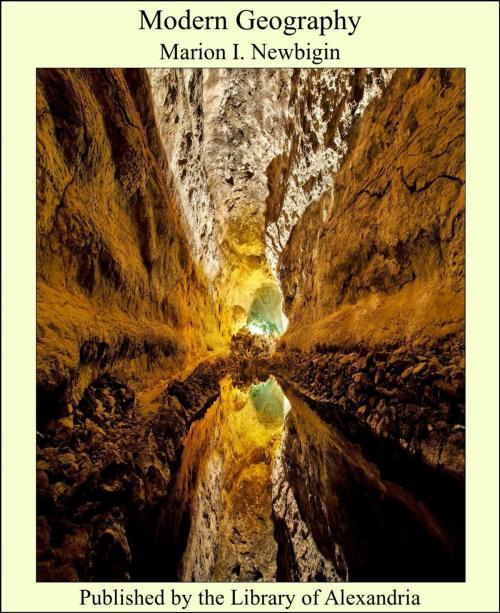| Author: | Marion I. Newbigin | ISBN: | 9781465535375 |
| Publisher: | Library of Alexandria | Publication: | March 8, 2015 |
| Imprint: | Language: | English |
| Author: | Marion I. Newbigin |
| ISBN: | 9781465535375 |
| Publisher: | Library of Alexandria |
| Publication: | March 8, 2015 |
| Imprint: | |
| Language: | English |
In the year 1859 there occurred three events which, though not all comparable to one another, yet make the year one of such importance that we may take it as marking the beginning of the distinctively modern period of geographical science. These three events were, first, the deaths of Humboldt and Ritter, two great geographical pioneers who hewed tracks through the tangled jungle of unsystematised geographical facts, and second, the publication of the Origin of Species, by Charles Darwin, a book which supplied the compass which has made Further road-making in that same jungle possible. In Other words, as a result of the life-work of the two great geographers named, and of the throwing by Charles Darwin of a new ferment into the mass of contemporary thought, what had been a mere collection of facts began to be a reasoned and ordered science. Both Humboldt and Ritter lived to a great age, so that at the time of their deaths not only was their work done, but there had been time also for their influence to permeate the literature of the subject. Humboldt was, above all, a great traveller, but he was also a man of science in the largest sense, interested not in one group of facts, but in many. The extent of his knowledge and the breadth of his interests enabled him to observe a vast number of phenomena while his particular genius was manifest in the way in which he correlated these, and considered them in their relation to each Other. Though it is true that his influence was most direct in the case of natural history, yet in this respect also he pointed to the future, for the geographers of to-day are indebted to the naturalists for some of their finest generalisations. Ritter was a great teacher, the prototype of those who alike by their personal influence and by their books have enriched geographical science within the last fifty years. He had not Humboldt’s breadth of knowledge and interest, but in the stress which he laid upon the earth as above all interesting in that it is the field of the activity of man, he emphasised an aspect of the subject in which perhaps the most interesting modern developments have taken place. Darwin had a twofold effect upon the progress of geography. In the first place, in his detailed work, e. g. in connection with coral reefs, and with the distribution of animals, and less directly in his investigation of the part played by earthworms in the formation of soil, he himself added to geographical knowledge. But he did much more than this. The doctrine of evolution which he made common property has had and is having an enormous effect upon geographical science, both directly and indirectly. As is well known, in connection with his own theory of the cause of evolution, Darwin laid great stress upon the “Struggle for Existence.” But he himself expressly stated that he used the term in a “large and metaphorical sense,” a sense which in popular language it has tended to lose. From the geographer’s standpoint, therefore, it is better to say that Darwin’s work has added a new interest to the study of interrelations. Humboldt, as we have indicated, was greatly interested in such subjects as the connection between the climate of a region and the vegetation, between the activities of man in a particular region and the physical conditions, and so on. But Darwin added a new interest to such studies. For example, it is a curious fact that desert plants have often spiny leaves, long roots, and so forth, and it is interesting to note how these peculiarities fit the plants for life in an arid climate. But when Darwin showed that there was evidence that the physical conditions of the desert gave rise to certain types of vegetation, it became worth while to study both the physical conditions and the characters of the plants in much greater detail than before
In the year 1859 there occurred three events which, though not all comparable to one another, yet make the year one of such importance that we may take it as marking the beginning of the distinctively modern period of geographical science. These three events were, first, the deaths of Humboldt and Ritter, two great geographical pioneers who hewed tracks through the tangled jungle of unsystematised geographical facts, and second, the publication of the Origin of Species, by Charles Darwin, a book which supplied the compass which has made Further road-making in that same jungle possible. In Other words, as a result of the life-work of the two great geographers named, and of the throwing by Charles Darwin of a new ferment into the mass of contemporary thought, what had been a mere collection of facts began to be a reasoned and ordered science. Both Humboldt and Ritter lived to a great age, so that at the time of their deaths not only was their work done, but there had been time also for their influence to permeate the literature of the subject. Humboldt was, above all, a great traveller, but he was also a man of science in the largest sense, interested not in one group of facts, but in many. The extent of his knowledge and the breadth of his interests enabled him to observe a vast number of phenomena while his particular genius was manifest in the way in which he correlated these, and considered them in their relation to each Other. Though it is true that his influence was most direct in the case of natural history, yet in this respect also he pointed to the future, for the geographers of to-day are indebted to the naturalists for some of their finest generalisations. Ritter was a great teacher, the prototype of those who alike by their personal influence and by their books have enriched geographical science within the last fifty years. He had not Humboldt’s breadth of knowledge and interest, but in the stress which he laid upon the earth as above all interesting in that it is the field of the activity of man, he emphasised an aspect of the subject in which perhaps the most interesting modern developments have taken place. Darwin had a twofold effect upon the progress of geography. In the first place, in his detailed work, e. g. in connection with coral reefs, and with the distribution of animals, and less directly in his investigation of the part played by earthworms in the formation of soil, he himself added to geographical knowledge. But he did much more than this. The doctrine of evolution which he made common property has had and is having an enormous effect upon geographical science, both directly and indirectly. As is well known, in connection with his own theory of the cause of evolution, Darwin laid great stress upon the “Struggle for Existence.” But he himself expressly stated that he used the term in a “large and metaphorical sense,” a sense which in popular language it has tended to lose. From the geographer’s standpoint, therefore, it is better to say that Darwin’s work has added a new interest to the study of interrelations. Humboldt, as we have indicated, was greatly interested in such subjects as the connection between the climate of a region and the vegetation, between the activities of man in a particular region and the physical conditions, and so on. But Darwin added a new interest to such studies. For example, it is a curious fact that desert plants have often spiny leaves, long roots, and so forth, and it is interesting to note how these peculiarities fit the plants for life in an arid climate. But when Darwin showed that there was evidence that the physical conditions of the desert gave rise to certain types of vegetation, it became worth while to study both the physical conditions and the characters of the plants in much greater detail than before















